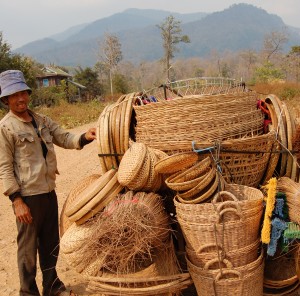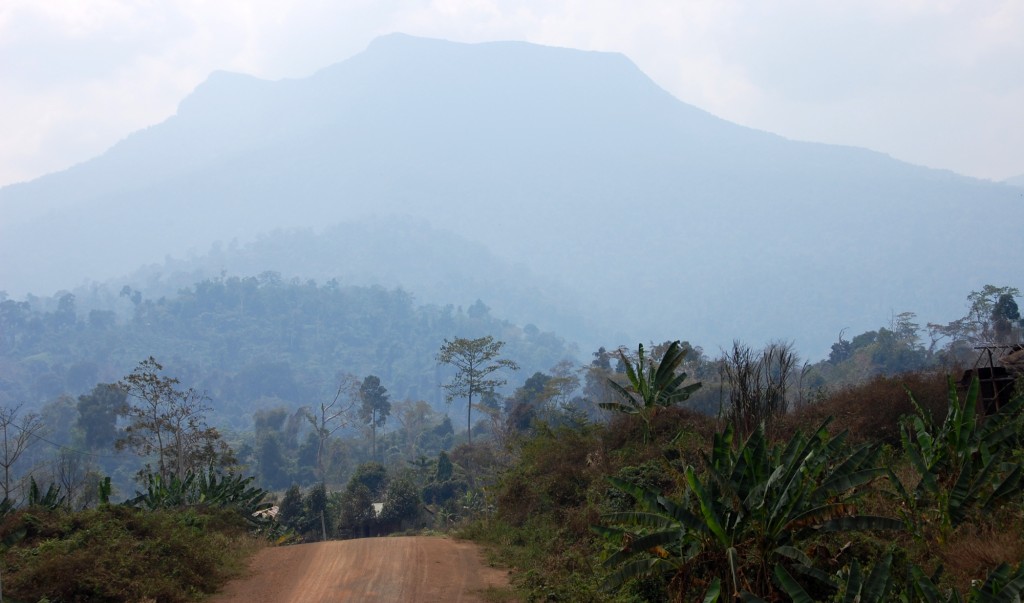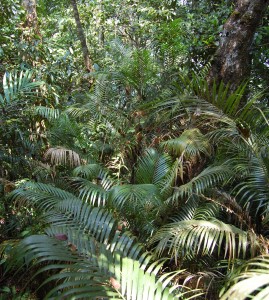Seeking Rattans in Cambodia
Posted in Nuggets from the Archives on November 1, 2013 by Andrew Henderson
Andrew Henderson, Ph.D., is the Abess Curator of Palms in the Institute of Systematic Botany at The New York Botanical Garden. His current research project concerns the systematics and conservation of the economically important rattan palms of southeast Asia.

This past February I returned from my second trip to Laos and Cambodia as part of our project Strengthening Sustainable Rattan Market and Industry in Mekong Region, funded by the World Wildlife Fund. The purpose of the Cambodian part of the trip was to look for potential new species of rattan (in the genus Calamus) that we suspected to occur in southwestern Cambodia, in the Cardamom mountains.
Myself and the whole of the local WWF rattan team (Khou Eang Hourt, Chey Koulang, Ou Ratanak, and Prak Ousopha), as well as the Vietnamese director, Mr. Tam Le Viet, left Phnom Penh on Sunday, February 3, and drove almost clear across the country to Pailing, near the border with Thailand. Most of the way was through the floodplain of the Great Lake, but even there we found a species of rattan, Calamus salicifolius, growing along the margins of rice fields and sometimes right next to the road.
This part of Cambodia, near Pailing, was one of the last strongholds of Pol Pot and his followers, and the area was heavily mined in the late 1970s and early ’80s. Many of the explosives are still there and it’s somewhat disconcerting to walk through areas with warnings about land mines. Our local guides didn’t seem to care, but I was careful to try and follow in their footsteps!
After much searching we eventually found the rattan in a piece of forest near the road, and were able to make a collection. It’s definitely a new species, a real beauty called the honey rattan because the cut stems smell of honey. When we returned to the road we stopped at a house to press the specimens. A young mother and her small daughter were there, and while I pressed the palms, there was a huge discussion about something I could not understand. I asked Hourt what the lady was saying. Apparently, a few months previously, her eight-year-old son had found a shell–not a mine but some kind of artillery shell–and had been playing with it behind the house. You know what happened next. The shell exploded, killing the boy and injuring his sister, now sitting there so quietly with her mother.

We drove the next day to look for our second species. This was a montane species that local people said grew only on the tops of mountains. We drove to Pursat, where we left Ratanak, Sopha, and Mr. Tam who returned to Phnom Penh. Myself, Hourt, and Mr. Lang then continued to a small town called Pramoy. The plan was that Hourt and local guides would walk up a mountain, get the palm, and then return the next day. Mr. Lang and I would cruise around in the lowlands. However, things did not go well. Hourt could not find any guides and there was much discussion about how to find the palm. Eventually we were told there was a road going across a mountain pass and into Thailand and we could find the palm there. We were also told it was a very dangerous place because of the land mines. The place was called Khnang 1500, meaning 1500-meter ridge.

We went to the place the next day. It was beautiful. We drove from the hot, completely deforested lowlands towards the ridge that we could see in the distance. Suddenly we were driving up the hill through totally undisturbed forest, full of palms. I counted 15 species, just from the car. We arranged for a guide for the next day, with high hopes, returning the next morning and setting off up the mountain. Our guide was a hunter and knew all the trails. After a few hours walk we reached the place of the palm, and there it was, a completely distinct, new species. We sat down and had lunch and then spent a couple of happy hours collecting and photographing the palm.
We spent the last few days of our trip looking for another potential new species in the central part of Cambodia, near Kompong Thon. Here, as elsewhere in Cambodia, there is terrible deforestation. I personally doubted we would find the palm, but Hourt was completely optimistic. I tried to explain the concept of the wild goose chase but Hourt was undeterred. However, even he had to admit defeat after hours of talking to local folks and trying to pin the place down. We returned to Phnom Penh on Saturday, February 9, and I flew back to New York on the following Tuesday.
Photos by Andrew Henderson.
This story was originally posted on February 27, 2013.

